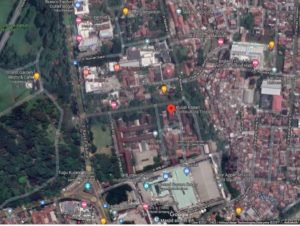Seminar Nasional Perhorti 2015 di Bogor 19-20 Oktober 2015
Monthly Archives: November 2015
Resistance of Several Capsicum annuum L. Genotypes to Anthracnose caused by Colletotrichum acutatum and Their Correlation with Capsaicin Content and Peroxsidase
Anthracnose is one of the most destructive pepper diseases in Indonesia. Colletotrichum acutatum has been identified as a predominant species in pepper fields of Asian countries including Indonesia. The experiment used completely randomized block design with 2 factors and 4 replications. The first factor was 14 genotypes (c-1,2,3,4,5,7,8,9,15,18,19,28,47, and 49, and the second factor was 4 isolates of C. acutatum (PYK 04, BGR 027, MJK01, and PSG 01). Each experimental unit used 10 green pepper fruits. Inoculation methods followed the AVRDC procedure and resistance score followed the modified procedure of Yoon method. Symptoms were evaluated five days after inoculation. Disease incidence was evaluated using Yoon method with slight modifications. The experiments showed that C-15 genotype was more resistant to anthracnose than others; C-8 and C-49 genotypes were recorded as susceptible to anthracnose. Except the three genotypes, all other genotypes were recorded as highly susceptible to anthracnose. Capsaicin content and peroxsidase activities were not correlated with resistance to anthracnose.
Key words: pepper, resistance, anthracnose, Colletotrichum acutatum
The Estimation of Varian Component, Heritability, and Correlation to Determine Selection Criteria in the F5 Population of Pepper (Capsicum annuum L.)
Abstract. Information on genetic variability and correlation between quantitative characters with yield are important for support the selection program. The objective of the research was to estimate the genetic variability, heritability, and path analysis on agronomic characters to determine the selection criteria in the chili. This research was conducted at Research Station of Leuwikopo, Darmaga, Bogor from November 2009 until May 2010. This research observed all populations i.e. F5 population: 320 plants, IPB C2 population: 20 plants, and IPB C5 population: 20 plants. The results showed that total fruit weight, thick and fruit diameter, middle fruit diameter, blossom end fruit diameter, fruit weight, and days to flowering have a high broad sense heritability . High coefficient of genetic variability values were obtained ini number of fruits per plant, fruit weight, stem diameter, fruit diameter, and fruit weight. Based on the heritability, genetic variability, correlations analysis and path analysis, characters that can be used as selection criteria in this study is the number of fruit per plant, fruit weight, and fruit diameter.
Key words: genetic variability, heritability, path analysis, selection
EVALUASI KERAGAMAN GALUR MUTAN ARTEMISIA HASIL IRADIASI GAMMA
Abstrak. Serangan penyakit malaria di Indonesia terus meningkat. Di lain pihak, penyebab penyakit ini yaitu Plasmodium falciparum telah resisten terhadap obat malaria yang selama ini digunakan. Artemisinin, dari tanaman artemisia telah diteliti dapat mengendalikan malaria. Permasalahan yang dihadapi adalah kandungan artemisinin dari Artemisia annua yang ditanam di Indonesia masih sangat rendah, yaitu berkisar 0.1 — 0.5 %. Peningkatan keragaman genetik artemisia dengan menggunakan iradiasi sinar gamma merupakan metode alternative untuk mengatasi masalah tersebut. Pada penelitian sebelumnya telah dilakukan induksi mutasi pada biji artemisia dengan dosis 10-100 Gy. Planlet hasil iradiasi yang mempunyai perakaran yang baik, diaklimatisasi di rumah kaca dan galur mutan yang didapatkan ditanam di Kebun Percobaan Gunung Putri, Balittro dengan ketinggian 1545 m dpl. Sebagai pembanding digunakan tanaman yang berasal dari biji (kontrol biji) dan tanaman dari kultur in vitro yang tidak diradiasi (kontrol in vitro). Hasil penelitian menunjukkan bahwa galur-galur mutan memperlihatkan keragaman morfologi, antara lain tinggi tanaman, bentuk daun, umur berbunga. Galur mutan umumnya berbunga lebih lambat dibandingkan tanaman kontrol. Sepuluh galur mutan telah terseleksi berdasarkan bobot basah dan bobot kering tanaman yang kemudian di analisis kandungan artemisininnya. Hasil penelitian menunjukkan kandungan artemisinin dari galur mutan bervariasi antara 0.44 — 1.41%, sedangkan kandungan artemisinin dari tanaman kontrol in vitro adalah 0.43%.
Kata kunci : Artemisia annua L, artemisinin, induksi mutasi, galur mutan
Diallel Analysis using Hayman Method to Study Genetic Parameters of Yield Components in Pepper(Capsicum annuum L.)
Abstract. One method to obtain genetic information is the diallel cross analysis. The objective of this study was to evaluate the genetic parameters of six inbred pepper (Capsicum annuum L.) using full diallel crosses. The experiment was conducted at IPB Experiment Field, Cikabayan, Darmaga. The design was randomized complete block design (RCBD) using three replications as blocks. Data from generation F1 and parents were analyzed using the Hayman Method. Results indicated that no epistatic effects were significant for all the traits assessed. Additive genetic effects were larger than the dominant effects for yield per plant, fruit length, and diameter fruit traits. Dominant genetic effects were larger than the additive effects for fruit weight traits. Narrow-sense and broad-sense heritability were high for all the traits assessed. The character of the yield per plant, fruit weight and fruit diameter shows that there were more dominant genes in the parents. There were more recessive genes in parents for the fruit length character. IPB C7 parent was the most recessive genes containing control characters in the yield per plant. In the new improved varieties of high yielding, IPB C7 could be crossed with IPB C9. Employing individual or mass selection breeding should be successful in developing high-productivity lines in this population.
Key words: pepper, additive effects, dominant effects, yield component, full diallel


